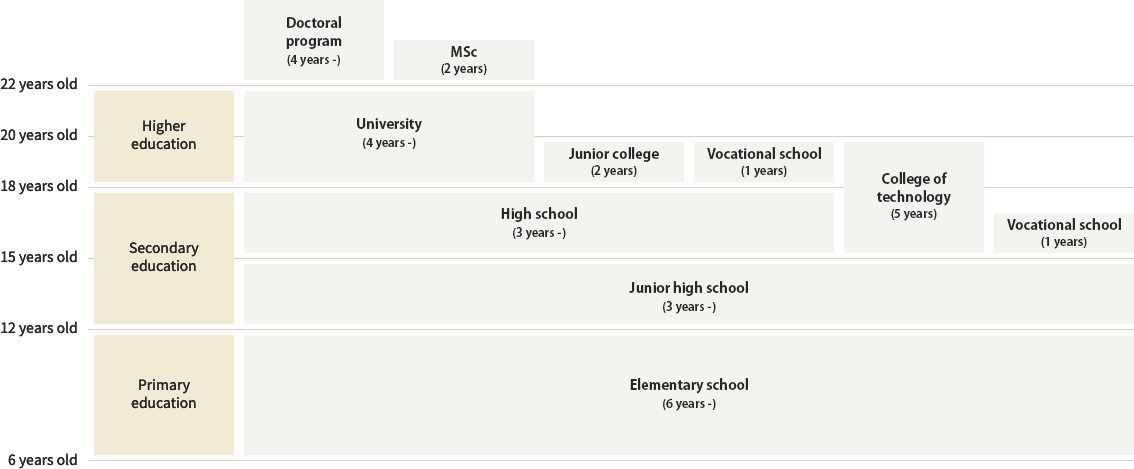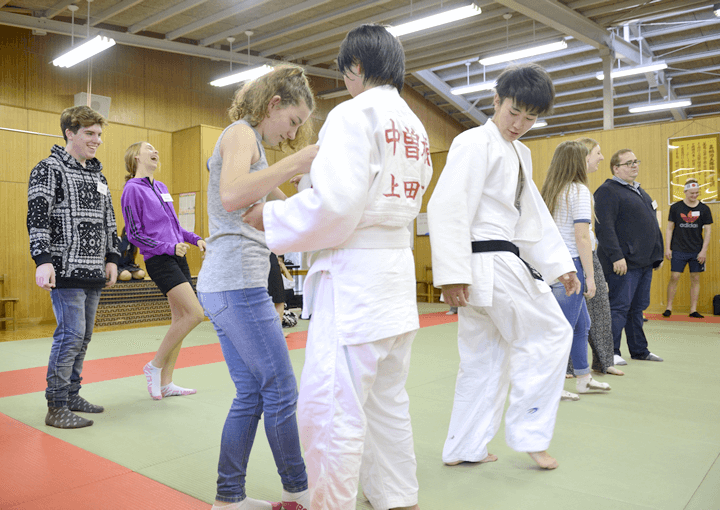Curriculum Outline
The Japanese school system primarily consists of six-year elementary schools, three-year junior high schools and three-year high schools, followed by a two-or-three-year junior colleges or a four-year colleges. Compulsory education lasts for 9 years through elementary and junior high school. School exchanges during Japan Educational Travel are mainly implemented in junior high and high schools. For physically or mentally challenged students, there is a system called “Special Needs Education” to support special students to develop their self-reliance and thus enhance their social participation.
School Education Chart

Introduction to Schools in Japan
eventSchool Timetable
Public schools in Japan have classes five days a week, from Monday to Friday. There are also schools that have classes on Saturday. In junior high and high schools, there are six class periods each day, typically lasting 50 minutes for each. After classes, students clean the classrooms in shifts and then start their club activities. There are a variety of clubs such as cultural and sports ones.
An Example of School Timetable

eventAcademic Calendar
In principle, the school year begins in April and ends in March of the following year. Most schools adopt a three-semester system, with the first semester from April to August, the second semester from September to December, and the third semester from January to March. There is also a summer break (from the end of July to the end of August), a winter break (from the end of December to the beginning of January), and a spring break (from the end of March to the beginning of April).
An Example of Academic Calendar

eventSchool Organization
Each school has a principal, a vice principal, teachers, a school nurse, and other administration staff. As the chief executive, the principal assumes all responsibilities of the school, including the courses provided and related administrative work. The vice principal supports the principal to manage administrative affairs of the school and to be in charge of student’s educational activities and curriculum as well. Furthermore, in order to ensure school’s smooth operation, teachers take on various responsibilities, such as taking care of educational activities, students’school life, and employment guidance for students after graduation. Many schools also establish their own committees, for example a International Exchange Promotion Committee, and others.
Related Information
Special Features of Japanese Education
About Features of Japanese Education.
eventRegarding the Level of Education
The level of Japanese education is high even by world standards. In
OECD’s Programme for International Student Assessment (PISA) aimed at
fifteen-year-olds, Japanese students recorded high levels of
achievement, particularly in science related areas. Educational
activities outside of school also flourish, and programs leading to
advanced education are implemented.
Enrollment in high schools, the second-half of secondary education,
reaches over 90%, and the enrollments in college are also high
reaching over 50%. Admission to high schools and colleges is mainly
through entrance exams, held from January to March.
Source:
OECD
location_cityForeign Language Education
English is a compulsory subject in junior high and high schools. There are also elementary schools that introduce English education from intermediate grade classes. In some high schools, apart from English, students are also allowed to take courses in Chinese, Korean, French, German, etc.
location_cityStudent Clubs
Student clubs are a characteristic part in Japan’s school education. Under teachers’ guidance, students with the same interests in sports, cultural activities, or fields of study voluntarily gather together after classes and on days off. There are also numerous student clubs revolving around Japanese traditional sports and culture, such as judo, kendo(Japanese swordsmanship), sado (Japanese tea ceremony), kado (Japanese flower arrangement), shodo (Japanese calligraphy), etc. Club activities also provide students with the chance to participate in school exchange and friendly matches.
Sports Clubs
- Baseball
- Soccer
- Volleyball
- Basketball
- Track and Field
- Swimming
- Judo
- Kendo (Japanese swordsmanship) etc.
Culture Clubs
- School Band
- School Choir
- Drama
- Art
- Literature
- Kado (Japanese flower arrangement)
- Sado (Japanese tea ceremony)
- Shodo (Japanese calligraphy) etc.




















